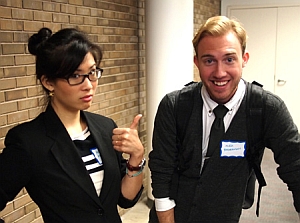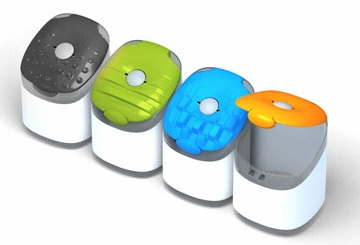Two undergraduate students of design at University of Cincinnati in Ohio have designed and built a prototype of a prescription-medicine pill bottle that better serves the needs of the blind and visually impaired. Alex Broerman and Ashley Ma will display their device, for which a provisional patent has been filed, at the DAAPworks 2012 show, 5 to 9 June, that highlights the creative work of students in the university’s College of Design, Architecture, Art, and Planning.
Broerman and Ma designed the new pill bottle to fill the special needs for the more than 1.3 million Americans who are legally blind as well as those who suffer less-severe vision impairment. The American Foundation for the Blind cites a 2003 Business Week article that says medicines have become the fifth leading cause of death among seniors. The Agency for Healthcare Research and Quality says the number of hospital admissions for Americans age 45 and older from medication and drug-related conditions doubled between 1997 and 2008.
The dispenser, illustrated below, has a small rectangular bottle body, two-by-two inches wide and three-inches tall, that allows a user to easily reach in and pick out a pill or two without the need to pour out a larger supply into the palm for subsequent selection of the required dosage. The top to the dispenser has hinges that allow the top to flip open but stay attached, which solves the problems of difficulty to twist pill bottle caps or lost caps, while remaining child proof.
The flip-top lid has a distinctive texture that would correspond with a different medication. Broerman and Ma ruled out using braille symbols, given that only 10 percent of blind or visually-impaired people today can read braille. The lids would also have vivid distinguishing colors, for the population with limited eyesight who can still identify colors.
Ma says she and Broerman kept the design purposefully simple, low-tech, and inexpensive. “Options that are currently on the market,” says Ma, “are more expensive and complex, dependent on technology and requiring a more expensive outlay on the part of the end user to purchase them.”
Some of the more technologically-sophisticated solutions they found include a Wi-Fi connected prescription bottle cap that glows when it’s time to take medicine, a radio frequency identification (RFID) monitor that provides a vocal description of medication when a bottle is passed over it, and an audio recorder that requires the pharmacist to record verbal instructions that are played back when a bottle is placed atop the recorder.
“There are a lot of great technology-based solutions on the market already, but those are out of reach for users who can’t afford the time or money to learn these systems,” says Broerman. “We interviewed a number of blind and visually impaired users of medications, and the cost for an option like the RFID device is out of reach for many of them.”
The designers’ blog says they filed a provisional patent for the device last week. The blog also chronicles the research, design, testing, and construction of prototypes for the project.
Read more:
* * *



 RSS - Posts
RSS - Posts
[…] Students Design Pill Dispenser for Visually Impaired […]
[…] Students Design Pill Dispenser for Visually Impaired […]